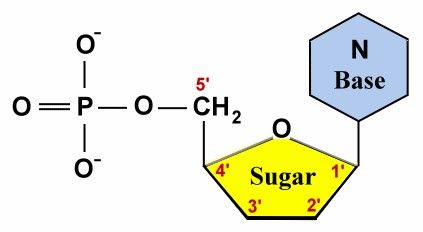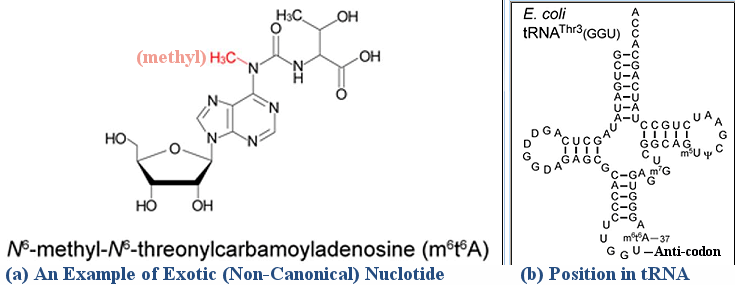|
In RNA, the sugar is ribose while in DNA, the sugar is deoxyribose (no oxygen is bonded in the 2' carbon) (Figure 11-14). And finally, there is the phosphate which forms part of the backbone (of the helix). The combination of the base and sugar is called nucleoside with the correponding products called (deoxy)adenosine, (deoxy)guanosine, (deoxy)cytidine, dexoythymidine and uridine. The product is called nucleotide with the additional element of phosphate (Figure 11-15); the naming convention is to add "5'-monophosphate" (5' indicates the 5th carbon) at the end, e.g., "adenosine 5'-monophosphate". The abbreviations are (d)AMP, (d)GMP, (d)CMP, (d)TMP, and UMP. Any of the nucleotide such as AMP can bond to additional phosphate groups. For example, adding another phosphate to AMP gives ADP (adenosine 5'-diphosphate) and ATP (adenosine 5'-triphosphate) when there are a total of three phosphates. ATP is a nucleotide that is used as a carrier of energy in cells. Energy is released when ATP is broken | | down to ADP and phosphate. As it will be explained further later, the energy package stored in the ATP serves to weld together the amino acid units in proteins and the nucleotide units in DNA and RNA, as well as the units in sugar and phospholipid molecules that abound in cells. The cAMP (c for cyclic) used by slime mould as molecular signal is a compound made from ATP. It is still used by more complex organisms for the same purpose. cAMP is widespread in animal cells as a second messenger in many biochemical reactions induced by hormones. Upon reaching their target cells, the hormones activate adenylate cyclase, the enzyme that catalyses cyclic AMP production. Cyclic AMP activates a cascade of enzymes, which results in a thousand-fold response just from the binding of a single hormone molecule to a receptor on the cell membrane. Cyclic AMP is also involved in controlling gene expression, cell division, immune responses, and nervous transmission. |






